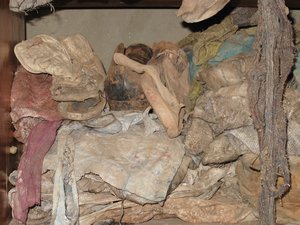Advertisement
Published: September 5th 2010

 Murambi Genocide Memorial
Murambi Genocide Memorial
This shows only a portion of the clothes, shoes and other articles collected that belonged to the victims of the killings in this area.Genocide - All Hell Breaks Lose (April 6th 1994 to July 18th 1994)
Within hours of the plane explosion and the death of all aboard the killings began. The plan that had been prepared over a long period of time was at last executed. Road blocks were set up, prominent Tutsis and Hutus targeted and executed. The nation went on a rampage. Killing, looting, raping, torturing and the destruction of property where the order of the day. The small UN peace keeping force ably led by Lt. Gen. Romeo Dalliare were unable to prevent the situation from escalating and getting out of hand due to the failure of the UN to intervene. The world had turned its back on the people of Rwanda in their greatest “hour of need”. UNAMIR (UN forces stationed within Rwanda at the time) were under instructions to monitor the situation and not get involved. After the death of 10 Belgium soldiers in April the UNAMIR contingent was reduced from its original 2500 to a mere 250.
During this period of time many Tutsis and moderate Hutus sought refuge in the Amahoro Stadium, Remero just outside Kigali, which was under the control of the UNAMIR,

 Murambi Genocide Memorial
Murambi Genocide Memorial
One on the many Mass graves at this memorial site.others took refuge in the now famous Hotel Collins De Mills (Hotel Rwanda) but the majority tried to flee the country. As the killings and destruction continued in May the UN agreed to send 6,800 troops to Rwanda to protect the civilians. This never eventuated because they couldn’t agree upon who would cover the costs or provide the equipment required. When the debate raged in the UN the word “genocide” was never mention (in relation to Rwanda) because if it had then the UN would have been obligated to step in and take action. It ids interesting that because one word, or actually the lack of use of this one word over a million people were “literally” butchered.
As the killing and destruction progressed throughout Rwanda the RPF made greater and greater inroads into the West and North of Rwanda. In June the RPF had control of Kigali airport as well as other strategic areas around Kigali. It was also during this month that the French committed 2500 peace keeping troops and commence “Operation Turquoise” which was the creation of a “safe zone” in the southwest of Rwanda. The idea behind the “safe zone” was to set up an

 Fishing - Lake Kivu
Fishing - Lake Kivu
1000s of bodies that were dumped into the rivers throughout Rwanda found their way to lake Kivu where they were fished out of the water.area where citizens could go and be protected. The problem with this concept was that as it became more obvious that the RPF was gaining more and more control of the country many of the “genocides” fled to the safe zone to avoid any repercussions of their actions. Suddenly the safe zone was being flooded with Hutu refuges. Refuge camps were springing up not only in the safe zone but in other countries mainly Zaire. Now a new humanitarian crisis began.
On July the 4th the RPF took control of Kigali and set up an interim government. By this stager all the former Hutu Government had fled to Zaire. On the 18th of July the RPF declared a cease fire and established a broad based government made up of Hutu and Tutsi ministers. By the end of August the UN had recognised that Genocide had occurred and replaced the French troops who had arrived earlier.
How many died in the Genocide? The figures written about generally talk about numbers between 800,000 to 1,000,000 plus. I get the impression though that these are conservative figures because whole families were wiped out and can never be accounted for. I remember

 Ntarama Church
Ntarama Church
Inside the church after the Hutu Militia had been through. The bodies had been removed.reading somewhere that the death toll could be as high as 2,000,000 or more. The reality is that we will never know.
For the following information I’d like to acknowledge the Bradt Travel Guide. “A Report in 2000 carried out by the Rwandan Ministry + Finance shows that the horrors of the 1994 Genocide has left large segments of the population in Rwanda with serve mental problems. In this report and earlier survey carried out in 1995 carried out by UNICEF titled National Trauma Survey estimated the % of children effected by genocide as follows:
99% witnessed violence
79.6% experienced death in the family
69.5% witnessed someone being killed or injured
61.5% were threatened with death
90.6% believed they would die
57.7% witnessed killings or injuries with machete
31.4% witnessed sexual assault or rape
87.5% saw dead bodies or parts of bodies
Advertisement
Tot: 0.11s; Tpl: 0.011s; cc: 9; qc: 48; dbt: 0.0385s; 1; m:domysql w:travelblog (10.17.0.13); sld: 1;
; mem: 1.1mb

 Murambi Genocide Memorial
Murambi Genocide Memorial
 Murambi Genocide Memorial
Murambi Genocide Memorial
 Fishing - Lake Kivu
Fishing - Lake Kivu
 Ntarama Church
Ntarama Church




